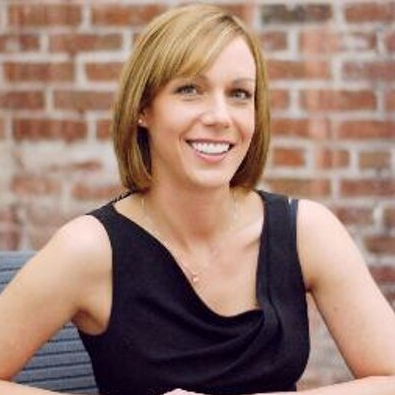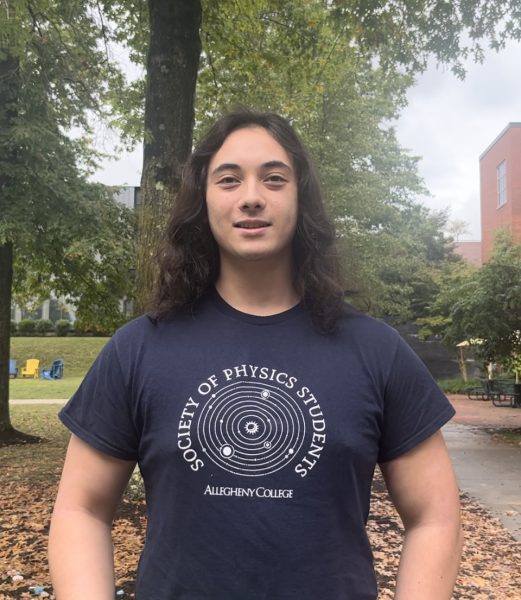Allegheny law and policy program hosts seminar on education funding

Rebecca Sebilia
Brown v. Board of Education ruled racial segregation unconstitutional, overturning the notorious “separate but equal” doctrine established by the antecedent case Plessy v. Ferguson. Despite this ruling, there is still a disturbing truth behind the American public education system.
Allegheny’s Law and Policy Program began its three-week series April 2, in Quigley Auditorium. CEO of EdBuild Rebecca Sebilia presented her lecture, “Fault Lines: How Our School Funding System is Entrenching Inequality.” Her talk focused on systematic inequality in American education. EdBuild is a nonprofit devoted to improving the way states fund public schools by gathering and unveiling concerning facts that define our current system.
“EdBuild is an amazing resource for citizens and policymakers across the country,” said Brian Harward, Robert G. Seddig chair of political science and director of the Law and Policy program. “(The EdBuild website) is remarkably powerful and full of compelling stories and data visualizations that really share some very hard truths about our country.”
Harward began the discussion with a history of the legal framework around education policy, speaking about the landmark decision made in Brown v. Board of Education.
“The promise of Brown remains unfulfilled … and it’s even been thwarted in many important respects,” Harward said. “In part, this is because the (Supreme Court) has read the 14th Amendment to prohibit only de jure segregation not de facto segregation. De jure segregation would be state imposed, whereas de facto segregation occurs due to private actions of individuals such as the private determination of where to buy a house.”
This reading of the Constitution places limits on the legal remedies federal courts can impose on de facto segregation, Harward said. Since the school a child will attend depends on where they reside and receives a substantial part of its funding from local property taxes, de facto segregation often results, as those who are capable move their children into better school districts.
Sibilia was introduced by Jared McHale, ’20, who aspires to work in the education field and apply the knowledge discussed during the lecture in his career.
“An eye opening report by EdBuild has been featured in recent national news,” McHale said. “The report details the $23 billion spending gap between predominantly white schools and those that predominantly serve students of color despite efforts to level the playing field. Rebecca’s work with EdBuild draws our attention to deep rooted inequity in our schools.”
Sebilia displayed a projection of a map of the United States that was colored with different shades of blue. The shades of blue signified the different poverty rates of every school district in the country, Sebilia said. The map also included the racial demographics of these districts.
“(In 1954), the (Supreme Court) said that you can never have a separate system because it will always be inherently unequal,” Sebilia said. “So, here we are in 2017 … and half of the students in our public school system attend a racially concentrated school district. When I say ‘racially concentrated,’ that is a school district where more than 75 percent of the students or either white … or non-white.”
Sebilia said there is a $23 billion gap between what is being spent on white districts compared to non-white districts and then described the internal dynamics of how education funding works.
Public schools are roughly funded by half by local funds, according to Sebilia, which are primarily property taxes, and half from the state. After a series of lawsuits arose over the heavy reliance on property taxes starting in the 1960s due to inequity of financial capabilities between communities, many states vowed to make up the difference between what poor and rich communities can raise.
“To put (national education spending) into perspective, it is 300 times what we spend on federal parks per year … it is the size of the national defense budget, which is the biggest spending line item in the federal appropriations bill,” Sebilia said. “That’s how big the money we spend on education is. So why are we still running one of the most inefficient systems around, particularly, what we’re doing with $600 billion for kids?”
Sebilia used the map to show divides in wealth and how they contribute to unequal education spending in Camden County, New Jersey, which is among the poorest counties in the nation. The county has lines drawing 32 separate school districts within a five mile radius of each other, and Sebilia identified two particular districts that convey an issue with wealth divides in districting.
“Camden City School District can only raise about $1,000 dollars (per student) from their property taxes because they have really low property value,” Sebilia said. “But Haddon Heights, which is (just northeast) … can raise $14,000 (per student) from the same tax rate. So why do you think these lines exist? Property taxes don’t cross borders, that is the answer.”
Sebilia said many states, despite stipulating a right to education in their state constitutions, have laws in place that allow the sort of redistricting shown in Camden to exist. As an example, Sebilia explained the case of Spencer-Sharples School District near Toledo, Ohio, which was in such a bad state that it was discredited. In response to this, residents of the Spencer-Sharples district appealed to neighboring counties for consolidation but were consistently denied.
“Because our school system is locally controlled … they can make that decision,” Sebilia said.
Finally, in 1967, the Ohio Board of Education responded to the situation by sending the remaining Spencer-Sharples residents who were left without a school district to Toledo, which was two districts away.
“These kids are getting bussed sometimes through two different school districts to get to class everyday because nobody wanted them,” Sebilia said. “So why not their neighbor? Why didn’t the (Ohio Board of Education) make their neighbor take them? The answer is political power, because the richer you are … the more power you have.”
Poverty rates in neighboring districts were significantly lower than Toledo’s, which stood at 37 percent, Sebilia said.
“Property taxes can’t cross borders but kids can,” Sebilia said. “Not necessarily by choice, but by edict.”
Parents who are concerned their children are being sent to school districts that provide a lower quality education can also face harsh legal recourse, Sebilia said. She mentioned the case of a mother named Kelly Williams who was sentenced to five years in prison for falsifying her address to send her kids to a different, better school district.
“There is a direct quote from school officials in this case, and what they said was … ‘Kelly was cheating because her daughters got a quality education that was not rightfully theirs,’” Sebilia said. “So kids can’t cross borders, and if you try you go to jail. That is the lesson.”
Sebilia then moved to Oakland, California, to Piedmont School District. The district has a peculiar border drawn around it that separates it from the rest of Oakland and lies in a community self-entitled as the “city of millionaires.”
“One of the reasons why Piedmont drew this border around themselves is because California has this loophole in their school funding system,” Sebilia said. “The loophole is that you can assess what’s called a parcel tax, which is a flat tax that every single house in a school district pays. Every single house pays this tax … and this happens completely outside of the state’s funding formula, so its like ‘phantom money’ that shows up.”
This parcel tax is something that most of the residents of Oakland cannot afford, and generates around $5,000 more per student for Piedmont School District. This “phantom money,” yields another pathway for disadvantaging districts that are less wealthy than others.
Sebilia discussed an African-American family who moved to Detroit in the 1970s and found that over 70 percent of the school district was non-white and sued the governor of Michigan over policies claiming to be perpetuating segregation. Their case, Milliken v. Bradley, won in the district court, which found that segregation was occurring and ruled for a plan to bus students across 53 other school districts in order to desegregate. The governor, however, subsequently appealed to the Supreme Court, which overturned the district court ruling, saying it does not have power to mandate desegregation. The Supreme Court argued it would not be justified by Brown v. Board of Education because there was no requisite racial balance or proportion in any school.
“(Milliken v. Bradley) is the single court case that reversed the intent of (Brown v. Board of Education) and took a lot of teeth out of it,” Sebilia said. “People were like ‘oh if we draw a line we can go back to segregated schools, and that is exactly what they are doing.”
This ruling has allowed occurrences such as the border between the cities of Grosse Pointe and Detroit, which Sebilia said to this day is the most segregated border in the country.
“The median property value in Detroit is about four times lower than that in Grosse Pointe,” Sebilia said. “So what that means in effect is that the people of Detroit are taxing themselves about four times higher just to get back to even.”
In Memphis, Tennessee, a school district that was significantly poorer than their neighboring Shelby County School District opted to let its district dissolve in order to have kids sent to the better, wealthier district. In response to this, wealthier residents went to their state legislator to demand the ability to create their own school system, who told them they could not do it because it was prohibited by the state constitution.
“They were like ‘well, then just amend the constitution’ … and that is literally what they did,” Sebilia said. “The legislators, in 2014, created the ability for small, wealthy, and white districts to create their own school system, fund their own schools, and keep the kids of Memphis out.”
After the seminar opened up to questions, one student asked Sebilia what can be done about these problems.
Sebilia responded that organizations like EdBuild handle advocacy for technical fixes, while passionate students and concerned citizens need to push for political fixes with the power of voice and advocacy for reform.
Andrew Bloeser, assistant professor of political science, asked what types of community partners are sought by organizations like Sebilia’s when deciding what communities to help.
“We focus a lot on helping journalists understand this issue, but when we go into a state and start re-designing a funding formula we look to put together a coalition of folks that can be around for a really long time,” Sebilia said. “We like to have (a 501(c)(4) organization) because they can give political money, which is a big threat. We also look for differences in ideology … working together because they can pull from both sides of the aisle.”
Sebilia hopes spreading awareness about the issues with the American public education system will galvanize citizens to take action.
“I know all this sounds hyperbolic but its not,” Sebilia said. “Everybody should care about this, because it is the erosion of democracy.”





